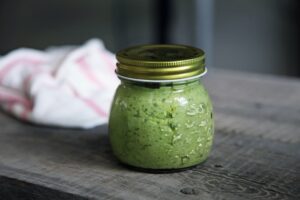Even though pesto is one of the most well-known icons of Italian food worldwide, not everyone is familiar with the roots and traditions that, in 2018, led to this remarkable sauce being nominated as a UNESCO intangible heritage.
Special ingredients and tools
Special ingredients and tools are typical of Liguria, a region in the north-western part of Italy, where the sauce, through its unique components, tells a story about the land and the city of its origin, Genoa. Basil, Parmigiano Reggiano, Pecorino, extra-virgin olive oil, pine nuts, and garlic are all typical products of this region and its neighboring areas. However, there is another element that makes pesto special: the traditional process used for its preparation. To achieve the correct taste and flavor, it is essential to use a marble mortar and wooden pestle.


Recipe and Preparation
Before delving into its history and the legend attributed to its origin, we would like to give the opportunity to the amateur cooks among our readers to learn how to recreate this wonderful sauce directly in their homes. Below, you will find the real and authentic recipe for Pesto Genovese:
- Place two cloves of garlic and a few grains of salt in a marble mortar and pound with a wooden pestle to a creamy consistency.
- Add a handful of pine nuts and continue to crush with the pestle.
- Gradually add a few basil leaves at a time, continuing to pound in a gentle rotating motion.
- Finally, add the two types of cheese and the extra virgin olive oil. Pesto is now ready to taste!
Between Legend and Reality: History and Origins of Pesto
Legend tells us that the well-known sauce was accidentally created for the first time by a friar who lived on the heights of Genoa. It is said that the monk was foraging for herbs in the vicinity of the monastery and, upon returning to the kitchen, added some ingredients (pine nuts, walnuts, and cheese) received as an offering from visiting believers. Both the herb and the monastery were named in honor of Saint Basilium.
For all the charm of the legend, however, it seems that the origins of Pesto are actually much older and less random than this story would have us believe. Some historians trace its origins back to the ancient Romans. During the Roman Empire, there is evidence of a green sauce called ‘moretum’, which was made with cheese, garlic, and herbs. The preparation and use of this sauce were so widespread that it was even described in a poem attributed to the famous Virgil.
Later, during the Middle Ages, another ancestor of Pesto appeared in the Ligurian region: ‘Agliata’, a sauce made from walnuts and garlic (‘aglio’ in Italian). Genoa was a great maritime power, one of the four maritime republics, and most of the population lived off this type of economy. Although the sauce was used by the entire population, it seems that it was particularly popular among seafarers to prevent the many diseases caused by the poor hygienic conditions of long sea voyages.
Conclusion
After discovering these curiosities about Pesto, it’s time to get down to business, or rather, as a true Italian would say, “è ora di mettere le mani in pasta” (literally, to put your hands in the dough)! Follow our recipe, make your homemade Pesto, and let us know how it tastes!
